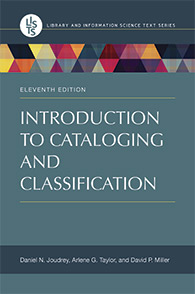|
|
|
| |
Contact Information |
Instructor: Professor Daniel N. Joudrey
E-mail: joudrey@simmons.edu
|
Office: C-330K
Phone: (617) 521-2863
Pronouns: he/him/his |
Class times:
Wednesday, 11-2pm
Office Hours:
Via Zoom, by appointment |
Important Syllabus Links:
|
|
|
| Course Description |
This course addresses the theories, principles, and practices of bibliographic description and the application of national standards to the construction of catalogs in libraries. It covers the fundamental concepts of descriptive cataloging including: the elements of bibliographic description, the choice of descriptive detail, the description of print and non-print resources, the choice of access points, the formulation of authorized names and titles, the principles and practices of authority work, and the application of encoding standards. The course also includes examinations of current trends and future directions of descriptive cataloging. May include readings, discussions, presentations, exams, exercises, and individual or group projects.
Prerequisites: LIS 415: Information Organization
Audience (level, environment/setting): Advanced; all kinds of libraries and other information institutions; people interested in working in cataloging, metadata services, technical services, media, archives, manuscript and rare book collections, and companies providing bibliographic services. |
|
| Relevant Student Learning Outcomes |
These outcomes are assessed in the course:
1. Apply professional standards, tools, and best practices in the information field and across specialized areas.
2. Communicate effectively across different audiences.
5. Demonstrate the technological skills required to help information professionals and organizations achieve their goals.
Students are exposed to these outcomes in the course:
7. Be guided by professional ethics and values.
|
|
| Course Learning Objectives |
At the end of this course, students will be able to:
A. Understand the role of descriptive cataloging in libraries.
B. Apply the core concepts, principles and objectives of descriptive cataloging.
C. Demonstrate basic skills in creating bibliographic metadata for information resources.
D. Demonstrate basic skills in creating authority metadata.
E. Understand the relationship between descriptive cataloging and information discovery.
F. Use key standards and tools in descriptive cataloging.
G. Use the vocabulary commonly associated with descriptive cataloging.
|
|
Course Structure |
This course will include the following approaches to teaching and learning:
- lectures,
- exercises,
- readings,
- discussions,
- homework assignments,
- presentations, or other group projects.
Many assignments will be partnered and there will be two group projects. The course structure and choice of assignments will be set by the first class meeting. |
|
Textbook

|
Required:
- Joudrey, Daniel, Arlene G. Taylor, and David Miller. Introduction to Cataloging and Classification, 11th edition. Santa Barbara, CA: Libraries Unlimited/ABC-Clio, 2015.
This title may be purchased from Simmons University Bookstore, Amazon, Libraries Unlimited, or other online retailers.
- RDA: Resource Description and Access. Chicago, IL: American Library Association, 2010. Subscription product. Access provided by SLIS! (The link is in Moodle.)
|
|
Grading Scale
|
For some assignments, letter grades will be used and for others you will receive grades based on percentages.
| Letter Grade |
Meaning |
Percentage Equivalents |
| A |
Excellent Performance |
94 - 100 % |
| A- |
Very Good Performance |
90 - 93 % |
| B+ |
Good Performance |
87 - 89 % |
| B |
Satisfactory Performance |
84 - 86 % |
| B- |
Marginal Performance |
80 - 83 % |
| C+ |
Unsatisfactory Performance |
77 - 79 % |
| C |
74 - 76 % |
| C- |
70 - 73 % |
| D+ |
67 - 69 % |
| D |
64 - 66 % |
| D- |
60 - 63 % |
| F |
Failing Performance |
Below 60 % |
|
|
Course Outline |
Unit 1: Introduction and Foundations
Unit 2: Describing and Identifiying Resources
Unit 3: Encoding and Display
Unit 4: Access Points and Authority Work |
|
|
|
|
|